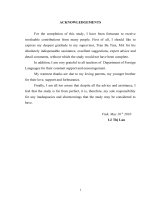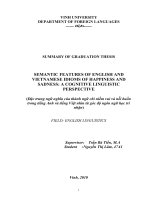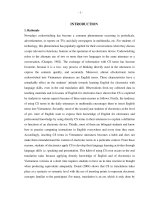CONDOLENCE STRAGIES USED BY AMERICAN SPEAKERS OFENGLISH AND VIETNAMESE SPEAKERS OF ENGLISHIN OFFICE SETTING
Bạn đang xem bản rút gọn của tài liệu. Xem và tải ngay bản đầy đủ của tài liệu tại đây (387.53 KB, 65 trang )
VIETNAM NATIONAL UNIVERSITY
UNIVERSITY OF LANGUAGE AND INTERNATIONAL STUDY
FACULTY OF ENGLISH LANGUAGE TEACHER EDUCATION
BA THESIS
CONDOLENCE STRAGIES USED BY AMERICAN SPEAKERS OF
ENGLISH AND VIETNAMESE SPEAKERS OF ENGLISH
IN OFFICE SETTING
Supervisor:
Lai Thi Thanh Van, M.A.
Student:
Nguyen Ban Mai
Course:
QH-2008
HA NOI – 2012
ĐẠI HỌC QUỐC GIA HÀ NỘI
1
TRƯỜNG ĐẠI HỌC NGOẠI NGỮ
KHOA TIẾNG ANH SƯ PHẠM
KHÓA LUẬN TỐT NGHIỆP
CHIẾN LƯỢC CHIA BUỒN BẰNG NGÔN NGỮ ANH CỦA NGƯỜI MỸ
VÀ NGƯỜI VIỆT TRONG BỐI CẢNH VĂN PHÒNG
Giáo viên hướng dẫn:
ThS. Lại Thị Thanh Vân
Sinh viên:
Nguyễn Ban Mai
Khóa học:
QH-2008
HÀ NỘI – NĂM 2012
RENTENTION AND USE OF THE THESIS
2
I hereby state that I: Nguyễn Ban Mai, 08.1.E15, being a candidate for the
degree of Bachelor of Arts (TEFL) accept the requirements of the College relating
to the retention and use of Bachelor’s Graduation Paper deposited in the library.
In terms of these conditions, I agree that the origin of my paper deposited in
the library should be accessible for the purposes of study and research, in
accordance with the normal conditions established by the librarian for the care,
loan or reproduction of the paper.
Nguyễn Ban Mai
May 2012
ACKNOWLEDGEMENTS
3
First of all, I would like to express my deepest gratitude to my supervisor, Ms.
Lại Thị Thanh Vân, MA. for her continuously support, patience, encouragement and
valuable and thorough feedback.
I would also like to send my heartfelt thanks to my close friends and my
classmates at University of Language and International Studies, who have stayed by
my side and supported me every time I need.
I also wish to express my special thanks to Ms. Lê Thị Huyền and her friends
and family, who have helped me in delivering the questionnaires to American
speakers.
I cannot forget to acknowledge the important assistances of both Vietnamese
and American participants, whose names cannot be mentioned in the thesis. Their
contributions are highly appreciated.
Finally, I owe an enormous debt to my family for their continuous support and
unfailing love and encouragement.
ABSTRACT
4
Based on the theoretical background of cross-cultural communication, this
study aims at investigating the similarities and differences in condolence offering
strategies used in office setting by Vietnamese English speakers and American English
speakers. It focuses primarily on the popularity and preference of condolence
strategies in different situations.
To succeed in doing such research, the author of the study takes informants’
social parameters such as age, sex, marital status, living area, and occupation into
consideration. Besides, their surveyed responses are carefully analyzed to build a
frame, a common set of strategies in the field.
The conclusion is drawn from data analysis and findings are presented and
compared in a brief and concise way. Some common examples of condolence
extending strategies used by both VSE and ASE from the data are also presented and
illustrated with the hope of partially helping avoid cultural shock and communicating
breakdown.
TABLE OF CONTENTS
5
RENTENTION AND USE OF THE THESIS……………………………………
i
ACKNOWLEDGEMENTS………………………………………………………
ii
ABSTRACT………………………………………………………………………
iii
TABLE OF CONTENTS…………………………………………………………
iv
LIST OF TABLES AND FIGURES…………………………………………….
vi
LIST OF ABBREVIATIONS AND CONVENTIONS………………………….
viii
PART A: INTRODUCTION
1. Rationale of the study…………………………………………………….
1
2. Aims and objectives of the study…………………………………………
2
3. Scope of the study…………………………………………………………
3
4. Significance of the study………………………………………………….
3
5. Organization of the study…………………………………………………
4
PART B: DEVELOPMENT
1. Chapter 1: Literature Review………………………………………….
1.1.
Communication and Cross-cultural Communication…………………….
6
6
1.1.1. Communication……………………………………………………………
6
1.1.2. Cross-cultural communication…………………………………………….
7
1.2.
9
Speech acts…………………………………………………………………
1.2.1. Definition of Speech acts…………………………………………………
9
1.2.2. Classifications of Speech acts……………………………………………
10
1.3.
12
Politeness…………………………………………………………………
1.3.1. Definition of Politeness……………………………………………………
12
1.3.2. Politeness principles………………………………………………………
13
1.3.3. Politeness strategies………………………………………………………..
14
1.4.
19
Definition of Condolence …………………………………………………
6
1.5.
Realization of politeness strategies in extending condolences to the
relative of the deceased in office setting………………………………….
19
2. Chapter 2: Methodology…………………………………………………
23
2.1.
Research methods………………………………………………………….
23
2.2.
Participants and participant selection method…………………………….
23
2.3.
Data collection instruments……………………………………………….
24
2.4.
Procedure…………………………………………………………………
27
2.5.
Data analysis procedure……………………………………………………
28
3. Chapter 3: Results and Discussions……………………………………
3.1.
29
Realization of condolences extending strategies in American English and
Vietnamese English……………………………………………………….
3.1.1. Realization of condolences extending strategies in American English……
29
3.1.2. Realization of condolences extending strategies in Vietnamese English….
37
3.2.
Major similarities and differences…………………………………………
47
3.2.1. Similarities…………………………………………………………………
47
3.2.2. Differences…………………………………………………………………
48
PART C: CONCLUSION……………………………………………………….
51
29
1. Review of the major findings…………………………………………….
51
2. Limitations of the study ……….………………………………………….
52
3. Suggestions for further research………………………………………….
52
REFERENCES……………………………………………………………………
54
APPENDIX………………………………………………………………………
I
LIST OF TABLES AND FIGURES
7
Table 1
The five general functions of speech acts (Yule, 1996: 55)
Table 2
The percentages of condolence strategies used by ASE toward the
boss
Table 3
The percentages of condolence strategies used by ASE toward the
colleague
Table 4
The percentages of condolence strategies used by ASE toward the
employee
Table 5
Use of strategies as seen from American participants’ parameters
Table 6
The percentages of condolence strategies used by VSE toward the
boss
Table 7
The percentages of condolence strategies used by VSE toward the
colleague
Table 8
The percentages of condolence strategies used by VSE toward the
employee
Table 9
Use of strategies as seen from Vietnamese participants’ parameters
Table 10
Comparison of preferences of strategy between American
and Vietnamese informants
Figure 1
Diagram of communication process (Shukla, 2011: 2)
Figure 2
Nguyen Quang’s table of communication components (2004:292)
Figure 3
Possible strategies for doing the FTAs (Brown & Levinson, 1978:
65)
Figure 4
Nguyen’s schema of possible strategies for doing the FTAs
Figure 5
Questionnaire’s extract
Figure 6
Frequency of strategies used by ASE in terms of age
Figure 7
Frequency of strategies used by ASE in terms of gender
Figure 8
Frequency of strategies used by ASE in terms of marital status
Figure 9
Frequency of strategies used by ASE in terms of residence
8
Figure 10
Frequency of strategies used by ASE in terms of occupation
Figure 11
Frequency of strategies used by VSE in terms of age
Figure 12
Frequency of strategies used by VSE in terms of gender
Figure 13
Frequency of strategies used by VSE in terms of marital status
Figure 14
Frequency of strategies used by VSE in terms of residence
Figure 15
Frequency of strategies used by VSE in terms of occupation
LIST OF ABBREVIATIONS AND CONVENTIONS
9
ASE: American speakers of English
CP: Communicating Partner
FSA: Face-saving Act
FTA: Face-threatening Act
H: Hearer
S: Speaker
Soc-ser: Social & services
Str: Strategy
Sit. : Situation
Tech-sci: Technical & scientific
TEFL: Teaching English as a foreign language
VSE: Vietnamese speakers of English
PART A
INTRODUCTION
10
1. Rationale of the study:
Communication, undoubtedly, has become one of the most essential parts in
human’s daily life. When people communicate, meaningful information as well as
thoughts and ideas, emotions and expressions are created and exchanged mutually. As
a matter of fact, it is crucial to know not only what information to exchange but also
how the information is going to be conveyed. The available speech acts with a suitable
system of strategies have supported the ways people communicate quite effectively.
Communicators in their own mother tongue find it natural to speak and express their
minds in the way they normally do with the help of their existing “social norms and
conventions” (Thơm Thơm, 2005: 1). In intercultural communication, however, there
are real differences between cultural groups. Misunderstandings happen because of the
distinctness of strategies in the corresponding speech acts, which lead to
communication breakdown, confusion, shock and even disgust and hostility. As the
result, the intercultural communication studies as well as speech acts’ studies are,
indubitably, crucial in order to, somehow, “negotiate these differences and similarities
with insight and skill” (Martin & Nakayama, 2010: 84).
Nowadays, English is widely considered the most common and powerful
spoken language. In Vietnam context, thanks to the open policies and strong support
from the government, the number of learners of English has increased dramatically. At
Faculty of English Language Teacher Education - University of Languages and
International Study (FELTE – ULIS), students are English majors, many of whom will
work with speakers of English in the future. Hence, understanding the cultures of
English-speaking countries is very essential in order to communicate appropriately, as
Hall (1959: 186) once stated: “Communication is culture and culture is
communication”. For many years, Intercultural communication has been included in
the syllabus to provide students with background knowledge about how people from
differing cultural backgrounds communicate. However, within a short time it cannot
11
provide learners with every aspect of a specific culture. Thus, it is important to provide
students with comprehensive knowledge of communication in daily life situations,
especially delicate ones like funerals in which condolences play an indispensable part.
Condolences are quite common in every language and culture. They are among
the most “sensitive” areas of politeness in intercultural communication as well.
Additionally, offering condolence strategies have not been received much attention
from researchers as it should be, especially in terms of an intercultural communication
approach. From all the above reasons, the researcher would like to conduct a study on
the topic:
“Condolence strategies used by American speakers of English and
Vietnamese speakers of English in the office setting.”
2. Aims and objectives of the study
The main aims of this study are:
• To investigate how the Vietnamese speakers of English (VSE) verbally perform
the act of extending condolences to the deceased’s relatives as defined in
relation to the social factors assigned in certain situations;
• To investigate how the American speakers of English (ASE) verbally perform
the act of extending condolences to the deceased’s relatives as defined in
relation to the social factors assigned in certain situations;
• To find out if there are any prominent similarities and differences between the
ways the VSE and the ASE use verbal condolence strategies in relation to the
social factors assigned in the situations studied.
3. Scope of the study
The overall aim of this thesis is to investigate the intra-linguistic factors of
extending condolences, i.e. the verbal expressions of giving condolences employed by
12
VSE and ASE. Therefore, the paralinguistic and extra-linguistic factors are beyond the
scope of the study.
Moreover, to study the act of offering verbal condolences in a wide range of
social contexts is quite challenging for the researcher. As the result, the office setting,
where the verbal aspect is emphasized more strongly than other means of
communication, is chosen.
Additionally, the language investigated is English, which are the foreign
language to Vietnamese speakers and the mother tongue to American ones.
4. Significance of the study
Once it is accomplished, the thesis paper is expected to contribute several
benefits. First of all, it demonstrates the ways verbal condolences are extended in
English by Vietnamese and American speakers. Secondly, the comparison of condoling
strategies is conducted. On so doing, the researcher hopes that this paper will raise the
awareness of cross-cultural factors in expressing verbal condolences in such a delicate
occasion as a funeral and help learners of English who are either working with
Americans or living in the United States avoid cultural misunderstanding in crosscultural communication. Last but not least, this research can be a reliable linguistic
support for many Vietnamese learners of English who still have difficulty in
expressing verbal condolences in English.
5. Organization of the study
The study is divided into three main parts as follows:
Part A: Introduction – introduces the rationale, aims, scope, significance and
methods of the thesis.
Part B: Development
13
Chapter 1 – Literature Review– provides the background knowledge about
cross-cultural pragmatics by explaining major concepts of the subject, namely
Communication, Cross-cultural Communication, Speech Acts, Politeness and a
thorough review of the previous studies in the field.
Chapter 2 – Methodology – presents the methods which are used in this study
and the procedures that researcher follows to conduct the study. Then the research
design including data-collection instruments, subject selections and data-gathering
procedures are all introduced.
Chapter 3 – Results and Discussion – produces the results and discussions of
the findings.
Part C: Conclusion – ends the research by summarizing the main findings,
pointing out limitations as well as giving suggestions for further studies.
In addition, Appendices, in which the study’s sample questionnaires are
attached, and References are also included in this thesis.
PART B:
DEVELOPMENT
Chapter 1: Literature Review
14
1.1. Communication and Cross-cultural Communication
1.1.1. Communication
Communication is an integral instinct of all living things and it has played a
vital part in the development of human civilization. The term “communication” has
been defined in various ways. “Communication” has been derived from the word
“communis” in Latin which means “to share”. According to Dorn (?), “communication
is defined as a process by which we assign and convey meaning in an attempt to create
shared understanding”. Sharing the same opinion, Oxford Advanced Learner’s
Dictionary defines communication as “the activities or process of expressing ideas or
feelings or of giving people information”. It is understood that communication is
related to the process of exchanging information, ideas, and feelings in order to create
a mutual commonality. This communication process involves a sender (speaker) or
communication source, the subject matter of communication, expressions used for
communicating (encoding), the medium of communication, receiver(s) (hearer) of the
communication and the interpretation (decoding) and feedback. The diagram below
can demonstrate this process clearly:
SENDER >> MESSAGE >> ENCODING >> MEDIUM >> RECEIVER >> DECODING >> FEEDBACK
Figure 1: Diagram of communication process (Shukla, 2011: 2)
In this process, the last part, i.e. FEEDBACK is crucial in determining whether
the information understood by the receiver is in the same light with the sender’s
intention. Also, the subject matter of communication or the information is imparted
from the sender to the receiver by not only verbal means such as speeches, or songs
but also non-verbal ones like facial expression, body-language, touch, etc. Going
further, Nguyen Quang (2004: 292) has designed a diagram to introduce a thorough
overview of communication’s concept. (see figure 2)
15
Moreover, in Spencer-Oatey’s (2008: 66) perspective, communication is
considered as a form of “social interaction” and through this process, the “production”
and “interpretation” of “the communicator's intentions” are manifested as well.
Therefore, the social factors also play an indispensable role in a successful
communication.
In the nutshell, communication is seen as a tool with which human being use to
exercise their influence on others, bring out changes in their attitudes with each other,
establish and maintain their relationships. Communication is a major element of
human’s active life and a social activity which is pursued verbally through speech and
writing or nonverbally through behaviours.
1.1.2. Cross-cultural communication
Nowadays, due to the process of globalization, especially in the increase of
global trade, it is quite natural that people from different cultures have interactions
with each other. Therefore, in order to make the communication process operate
smoothly and to avoid the cultural shock, many studies on cross-cultural
communication have been carried out. Defined by Levine & Adelman (1993: 94),
cross-cultural communication is “communication (verbal or nonverbal) between
people from different cultures; communication that is influenced by cultural values,
attitudes, and behavior, the influence of culture on people’s reactions and responses to
each other”.
From the same point of view, Clarke & Sanchez (2001: 1) defined the term as
“a process of exchanging, negotiating, and mediating one's cultural differences through
16
Communication
Non-verbal Communication
Verbal Communication
Intralanguage
Lexicon
Rules of grammar
Rules of phonetics
Rules of language
use and
interaction skills
Paralanguage
Extralanguage
Vocal
characteristics
+ Pitch
+ Volume
+ Rate
Types of vocal
quality
Vocal
interferences
Silence
Body language / Kinesics
… Object language
Environmental language
Eye contact
Clothing
Setting
Facial expressions
Jewellery
Conversational
distances/ Proxemics
Gestures
Accessories
Postures
Make-up
Touch/ Haptics/
Tactile
Artificial scents
Colour
Flowers
Heat
Gifts
…
Time/ Chronemics
Lighting system
Figure 2: Nguyen Quang’s table of communication components (2004:292)
17
language, non-verbal gestures, and space relationships. It is also the process by which
people express their openness to an intercultural experience.”
Misunderstanding in cross-cultural communication is unavoidable, since the
differences between cultural backgrounds and communication styles always exist.
People tend to act and interpret others’ actions as well as speeches based on their own
cultural convention; hence, the more distinct differences the two cultures have, the
more easily the communication failure may occur. For instance, an American woman
invites her neighbor, who is a Japanese woman, to attend her birthday’s party at the
weekend. The Japanese woman politely refuses the invitation and, to the American
woman’s surprise, she announces that her husband has just passed away with a smile.
In this situation, there is a misunderstanding because of the lack of cross-cultural
communication knowledge. In America, people often express their ideas, thoughts and
feelings openly and directly, but in Japan, they tend to hide the negative feelings such
as anger or sadness with a smile. Therefore, if someone who doesn’t know this fact
encounters such an experience, they may feel surprised, confused, or even worse, they
may have disgusting or hostile feelings toward the communicating partner, which
leads to communication breakdown or cultural shock.
In short, in order to have a successful communication with people from other
cultures, it is necessary to enrich ones’ own background knowledge of different
countries and have a positive attitude when experiencing cultural differences.
1.2.
Speech acts
1.2.1. Definition of Speech acts
The speech acts theory is constantly viewed as a “compelling” component of
pragmatics. Numerous studies and discussions about the notion of speech acts have
been carried out since Austin first initiated the concept in How to do things with words
(1962) - his most influential work.
18
According to Yule, speech acts are “actions performed via utterances” and are
commonly given more “specific labels” like complaint, request, apology, invitation,
etc. To be more specific, in Austin’s (1962) point of view, an action performed by
producing an utterance will consist of “three related acts”, i.e. the “three dimensions”
of a speech act: locutionary act, illocutionary act and perlocutionary act.
• A locutionary act is the act of making a meaningful utterance.
• An illocutionary act is performed with S’s intention or purpose
delivered in the utterance.
• A perlocutionary act is the effects that H received from the utterance.
As an example, consider the following utterance:
Hey, I have a new album of S.E.N.S., would you like to borrow it?
The action of performing this utterance is the locutionary act since the utterance
has meaningful linguistic expression. Its illocutionary function is an offer, whereas its
perlocutionary effect might be H’s act of borrowing that album from S.
1.2.2. Classifications of Speech acts
Austin (1962) divided speech acts into 5 distinct classes:
• Verdictives: offer a certain state of facts as true (describe, declare not
guilty)
• Exercitives: convey a motive or inclination for a certain kind of
behaviour (command, advise)
• Commissives: commit S to a certain activity (promise, guarantee)
• Expositives: offer a certain view or position in an argument (agree,
negate, illustrate)
19
• Behabitives: reactions to the behaviour of other persons (apologize,
congratulate, swear)
Austin’s classification is considered as an “attempt” to give a general picture of
illocutionary act, which is S’s intention when performing utterances. Searle (1975) had
another way to classify speech acts. He also divided it into 5 major categories, but
unlike Austin, his classification concentrates on the way H responds after hearing the
utterance:
• Assertives = speech acts that commit a speaker to the truth of the
expressed proposition, e.g. reciting a creed
• Directives = speech acts that are to cause H to take a particular action,
e.g. requests, commands and advice
• Commissives = speech acts that commit a speaker to some future action,
e.g. promises and oaths
• Expressives = speech acts that express S's attitudes and emotions towards
the proposition, e.g. congratulations, excuses and thanks
• Declarations = speech acts that change the reality in accord with the
proposition of the declaration, e.g. baptisms, pronouncing someone
guilty or pronouncing someone husband and wife
Yule (1996: 55), based on Searle’s classification, has summarized the five
general functions of speech acts as the table below :
Speech act types
Declarations
Direction of fit
Words change the world
20
S = Speaker, X = Situation
S causes X
Representatives
Make words fit the world
S believes X
Expressives
Make words fit the world
S feels X
Directives
Make the world fit words
S wants X
Comissives
Make the world fit words
S intends X
Table 1: The five general functions of speech acts (Yule, 1996: 55)
1.3.
Politeness
1.3.1. Definition of Politeness
Politeness, in terms of culture, is best expressed as the practical application of
good manner or etiquette. As a “culturally-defined phenomenon”, what is considered
polite in a certain culture can become rude in another and vice versa. In order to make
the notion of politeness clear, the concept of face needs to be clarified. Yule (1996: 60)
has given a general definition of face:
“As a technical term, face means the public self-image of a person. It refers to
that emotional and social sense of self that everybody has and expects everyone
else to recognize.”
It is understood that face refers to the value that one individual has for
him/herself and one maintains such self-esteem in not only social but also personal
situations. Moreover, in everyone’s daily social interaction, people generally expect
that their “public self-image”, or their “face wants”, is respected by others. If someone
says something which may cause a threat to another individual’s self-esteem, this
action will be described as a “face threatening act” (FTA). In that case, if another says
something that might lessen the threat then that action is called the “face saving act” or
FSA.
Based on face’s concept, Yule (1996: 60) states that: “Politeness, in an
interaction, can be defined as the means employed to show awareness of another
person’s face. In this sense, politeness can be accomplished in situations of social
distance or closeness”.
21
Also based on the notion of face, Mills (2003: 6) proposes her opinion in
defining politeness: “Politeness is the expression of Ss’ intention to mitigate face
threats carried by certain face threatening acts toward another.”
Nguyen Quang (2006: 44), however, has his own definition of politeness which
emphasizes on communicative acts: “Politeness refers to any communicative act
(verbal and/or non-verbal) which is appropriately intended to make others feel better
or less bad.”
In this research, the researcher decides to choose the definition above as the
working definition of politeness.
1.3.2. Politeness principles
In Lakoff’s (1990: 34) opinion, politeness is “a system of interpersonal relations
designed to facilitate interaction by minimizing the potential for conflict and
confrontation inherent in all human interchange”. To emphasize this affirmation, she
proposes her own rules of politeness with 3 maxims (1977: 88):
• Formality: Don’t impose/ Remain aloof
S avoids imposition by asking permission or apologizing when asking H
to do something. For example:
Could you possibly bring this document to Mr. Smith for me?
• Hesitation: Give H his/her options
S gives options and let H make up his/her mind. For example:
I wonder if you could bring this document to Mr. Smith for me.
• Camaraderie: Make H feel good
S expresses his/her appreciation to H. For example:
I highly appreciate your support.
It can be seen clearly that the three rules above emphasize on individualism,
which means they are suitable to use in low-context cultures such as the US or Western
countries. In high-context cultures in the East, especially Vietnam where community is
highly valued, on the other hand, these rules are not always appropriate. Hence, they
might not be the universal politeness principles.
Leech (1983: 132) introduces his politeness principles with 6 maxims:
• Tact maxim: Minimize cost to other; maximize benefit to other.
22
• Generosity maxim: Minimize benefit to self; maximize cost to self.
• Approbation maxim: Minimize dispraise of other; maximize approval of
other.
• Modesty maxim: Minimize praise of self; maximize dispraise of self.
• Agreement maxim: Minimize disagreement between self and other;
maximize agreement between self and other.
• Sympathy maxim: Minimize antipathy between self and other; maximize
sympathy between self and other.
Leech’s maxims concentrate on the “cost” and “benefit” of speakers and
hearers; however, these notions themselves, as well as “minimize”, “maximize”, are
ambiguous in some particular cases.
1.3.3. Politeness strategies
Brown & Levinson (1978) use a schema to show their ideas:
Figure 3: Possible strategies for doing the FTAs (Brown & Levinson, 1978: 65)
Without redressive action,
baldly
Est
im
ati
on
of
ris
k
of
fac
e
los
s
Lesser
On record
2. Positive politeness
With redressive action
Do the FTA
3. Negative politeness
4. Off record
5. Don’t do the FTA
Greater
In their schema, there are five major components which are numbered from 1 to
5 and thus, decide the levels of possibility of face loss.
1. S goes on record: baldly performs the act without redressing action (such
as apology or mitigation). For example, S may give a command to H:
“Clean up this mess.”
2. S goes on record, performs the act with positive politeness strategy
which is “appropriately intended to show S’s concern to the addressee,
thus, enhancing the sense of solidarity between them” (Nguyen, 2005:
27). For example: “Let’s clean up this mess, shall we?”
23
3. S goes on record, performing the act with negative politeness strategy
which is “appropriately intended to show that S does not want to
impinge on the addressee’s privacy, thus enhancing the sense of distance
between them” (Nguyen, 2005: 30). For example: “I wonder if you could
possibly clean up this mess.”
4. S goes on off record, performs the act with implicature which means
using the utterance that are indirectly addressed to hearer. For example:
“What a mess!”
5. S might decide not to do the FTA so both speaker’s and H’s faces are not
threatened.
Sharing the same light with Brown & Levinson, Nguyen Quang (2005: 25)
makes some improvements to the schema:
FTA encounter
4. Do not do the FTA
Do the FTA
3. Off record
On record
4:
2. With redressive action
Positive
politeness
Negative
politeness
Without redressive action
Nguyen’s schema of possible strategies for doing the FTAs
24
Figure
Unlike Brown & Levinson’s schema in which the negative politeness are
considered more polite than the positive ones, in Nguyen Quang’s schema, negative
and positive politeness are equal.
1.3.3.1. Positive politeness and strategies
There are two distinct categories in the concept of face which the researcher has
mentioned above, one of which is the positive face. According to Yule (1996: 62), a
person’s positive face is “the need to be accepted”, to be considered as “a member of a
group” and to acknowledge that his/her wants are “shared by others”. Thus, a FSA
which is aware of an individual’s positive face tends to show “solidarity”, emphasize
that both speakers have “a common goal”. And this is called positive politeness.
Nguyen Quang (2005: 27) has concluded that:
“Positive politeness is any communicative act (verbal and/or nonverbal) which
is appropriately intended to show S’s concern to the addressee, thus, enhancing
the sense of solidarity between them.”
In his research, Nguyen Quang (2005) has come up with 3 main mechanisms of
positive politeness; each includes different strategies:
• Mechanism 1: Claim common ground
Strategy 1: Notice, attend to H
Strategy 2: Exaggerate
Strategy 3: Intensify interests to H in S’s contribution
Strategy 4: Use in-group identity markers in speech
Strategy 5: Seek agreement
Strategy 6: Avoid disagreement
Strategy 7: Presuppose, raise, and assert common ground
Strategy 8: Joke to put H at ease
• Mechanism 2: Display the sense of cooperation
Strategy 9: Assert or presuppose knowledge of and concern for hearer’s wants
Strategy 10: Offer, promise
Strategy 11: Be optimistic
Strategy 12: Include both speaker and hearer in the activity
Strategy 13: Give or ask for reasons
Strategy 14: Assert reciprocal exchange or tit for tat
• Mechanism 3: Satisfy hearer’s wants
Strategy 15: Give gifts to hearer
Strategy 16: Console and encourage
Strategy 17: Ask personal questions
1.3.3.2. Negative politeness and strategies
25









